Today Current Affairs: 11th December 2021 for UPSC IAS exams, State PSC exams, SSC CGL, State SSC, RRB, Railways, Banking Exam & IBPS, etc
Table of Contents
National Institute Of Pharmaceutical Education And Research (Amendment) Bill, 2021:
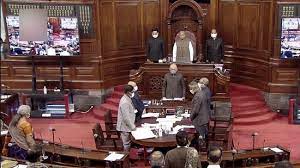
The Parliament has passed the National Institute of Pharmaceutical Education and Research (Amendment) Bill, 2021, with passing of the Bill in the Rajya Sabha and on 6th December in the Lok Sabha.
- The Bill seeks to amend the original act of 1998 to declare six additional National Institute of Pharmaceutical Education and Research as Institutions of National Importance.
- These institutes are located in Ahmedabad, Hajipur, Hyderabad, Kolkata, Guwahati and Raebareli.
- The Bill also provides for a Council to coordinate the activities among the institutes to ensure development of pharmaceutical education and research.
- The NIPERs are for strengthening and enhancing research in the Pharma sector, in the country.
Bird Flu:
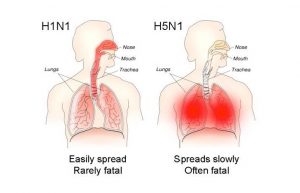
Fresh cases of bird flu have been confirmed in the Kuttanad region of Kerala. Response teams have been formed for culling birds in affected areas.
- Samples have tested positive for the H5N1 influenza virus.
- Bird flu also called avian influenza.
- It is a disease caused by avian influenza Type A viruses found naturally in wild birds worldwide.
- Symptoms have ranged from mild to severe influenza-like illness.
- Avian Influenza type A viruses are classified based on two proteins on their surfaces – Hemagglutinin(HA) and Neuraminidase(NA).
- There are about 18 HA subtypes and 11 NA subtypes.
- Several combinations of these two proteins are possible e.g., H5N1, H7N2, H9N6, H17N10, etc.
- There have been reports of avian and swine influenza infections in humans.
- The infection is deadly as it has a high mortality rate of about 60%.
- The most common route of virus transmission is direct contact. They can also be affected if they come in contact with contaminated surfaces or air near the infected poultry.
- There are no known cases of H5N8 in human beings. Risk to general public is very low.
- There is also no evidence that consumption of poultry meat or eggs could transmit the virus to humans. But necessary precautions are required while handling sick/dead birds and contaminated material during control and containment operations. It is considered safe to eat properly cooked poultry products.
- Culling is usually undertaken to control the infection when it is detected in animals.
- Besides culling, safe disposal of all such culled animals and animal products is also important.
- The authorities also need to strictly enforce decontamination of infected premises and undertake quarantine of contaminated vehicles and personnel.
Yusaku Maezawa:

Billionaire Japanese entrepreneur Yusaku Maezawa reached the International Space Station (ISS) for a 12-day trip, during which time he will complete 100 tasks in space, including playing a game of badminton.
- Maezawa and another space tourist Yozo Hirano–who will document the billionaire’s space flight–made the trip led by Russian cosmonaut Alexander Misurkin.
- The three reached the ISS aboard a Soyuz MS-20 that took off from the Baikonur cosmodrome in Kazakhstan.
- Companies including Virgin Atlantic, SpaceX, XCOR Aerospace, Jeff Bezos’s Blue Origin and Armadillo Aerospace are working on providing space tourism services to people.
- But Space Adventures is the only private company to send paying customers to orbital space so far, a report by the Congressional Research Service notes.
- In 2004, test pilot Mike Melville became the first private astronaut to fly beyond the Karman Line (recognised as the edge of space).
“Main Bhi Digital 3.0″ Campaign:

Main Bhi Digital 3.0″ campaign launched which is aimed at digital onboarding of Street Vendors who are provided loans under PM SVANidhi Scheme.
- Digital onboarding and training of Street Vendors (SVs) is an integral part of PM Street Vendor’s AtmaNirbhar Nidhi (PM SVANidhi) Scheme.
- Lending Institutions (LIs) have been instructed to issue a durable QR Code & UPI ID at the time of disbursement and train the beneficiaries in conduct of digital transactions.
- In order to give further impetus to the digital onboarding and training of beneficiaries, Ministry of Housing & Urban Affairs (MoHUA) and Ministry of Electronics & Information Technology (MeitY) jointly launched ‘Main Bhi Digital 3.0’from September 9 to November 30, 2021, to complement the efforts of LIs in adoption of digital transactions by the PM SVANidhi beneficiaries.
- PM SVANidhi Scheme is available to all street vendors across the country, including those from Dahod tribal area, who are engaged in vending in urban areas on or before March 24, 2020.
World Gold Council:

As per WGC’s ‘Bullion Trade in India’ report:
- Imports made up 86% of India’s gold supply between 2016-2020, and inbound shipments continue to grow despite high import duty.
- Since the first duty hike in 2012, India has imported some 6,581 tonnes of gold, averaging 730 tonnes per annum.
- In 2020, India imported 377 tonnes of gold bars and dore from over 30 countries, of which 55% came from just two countries — Switzerland (44%) and the UAE (11%).
- In the last five years, gold dore imports made up 30% of the total official imports of the yellow metal.
- Gold was used as the world reserve currency up through most of the 20th century. The United States used the gold standard until 1971.
- The demand for gold increases during inflationary times due to its inherent value and limited supply. As it cannot be diluted, gold is able to retain value much better than other forms of currency.
- When a country imports more than it exports, the value of its currency will decline. On the other hand, the value of its currency will increase when a country is a net exporter.
- Thus, a country that exports gold or has access to gold reserves will see an increase in the strength of its currency when gold prices increase, since this increases the value of the country’s total exports.
About the World Gold Council:
- It is the market development organisation for the gold industry.
- It works across all parts of the industry, from gold mining to investment, and their aim is to stimulate and sustain demand for gold.
- It is an association whose members comprise the world’s leading gold mining companies.
- It helps to support its members to mine in a responsible way and developed the Conflict Free Gold Standard.
- Headquartered in the UK, they have offices in India, China, Singapore, Japan and the United States
Bills To Extend Tenure Of ED And CBI Chiefs:
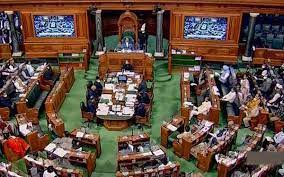
Amid strong objection from the Opposition, the Lok Sabha has passed two Bills allowing the Centre to extend the tenure of the Enforcement Directorate (ED) chief and the CBI Director up to five years from the current fixed tenure of two years.
- The Bills replace the ordinances brought in last month.
About the Ordinances:
- The Union Government has brought in two ordinances allowing the service of the directors of the Enforcement Directorate (ED) and the Central Bureau of Investigation (CBI) to be extended beyond their fixed tenure of at least two years up to a maximum of five years.
- The extension can be given only one year at a time. That is, after a fixed two-year tenure, they may get three annual extensions.
Laws amended:
- The change in tenure of the CBI Director was done by amending the Delhi Special Police Establishment Act, 1946.
- On the other hand, the changes to the tenure of the ED Director was brought in by amending the Central Vigilance Commission Act, 2003.
Plea in Supreme Court on new Ordinances:
- Petitions have been filed in the Supreme Court urging the Supreme Court to quash the Ordinances, which allow the Government to extend the tenures of the chiefs of the Central Bureau of Investigation (CBI) and Enforcement Directorate (ED) “in a piecemeal fashion” up to a maximum of five years.
- The petitioners said the Ordinances would leave the heads of the two top investigative bodies insecure about their tenure and erode their professional independence.
- Also, no criteria has been provided save for a vague reference to ‘public interest’ which is based on the subjective satisfaction of the Respondents.
- The Government’s move has also drawn sharp criticism from the Opposition parties, which have accused it of taking the ordinance route despite the Parliament session beginning on November 29.
The High Court And Supreme Court Judges (Salaries and Conditions of Service) Amendment Bill, 2021:
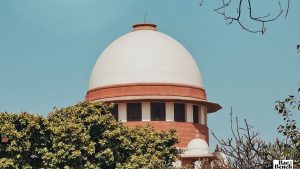
It was passed in Lok Sabha recently.
- The bill seeks to clarify the process of counting the age of retired judges to determine when they will get enhanced pension.
- The bill only inserts an explanatory note to make the legislative intent clear about the additional quantum of pension.
- Additional quantum of pension to retired judges of High Courts and the Supreme Court is being sanctioned on completing the age of 80, 85, 90, 95 and 100 years as the case may be, but there was a confusion about the process of calculating the age.
- The salary payable to a Supreme Court Judge was previously, specified in the Constitution in Article 125(1) and the Second Schedule.
- However, through the 54th Constitutional-Amendment, Parliament has gained the power to determine the salaries of Supreme Court Judges by law.
- Parliament also has the authority to determine questions relating to the privileges, allowances, etc., for these Judges.
- None of these can, however, be varied by Parliament to the disadvantage of a Judge after his appointment to the Court.
- These matters are now regulated by the Supreme Court Judges (Salaries and Conditions of Service) Act, 1958.
- Similarly, Parliament also has the authority to determine the salary of the High Court Judges by law.
Unified Payments Interface (UPI):

The UPI facility will soon be extended to feature phone users. At the moment, the unified payments interface (UPI) — the single largest retail payments system in the country in terms of volume of transactions for small-value payments — is available only for smartphones.
- RBI is doing this to further deepen digital payments and make them more inclusive, ease transactions for consumers, facilitate greater participation of retail customers in various segments of financial markets and to enhance the capacity of service providers.
- Unified Payments Interface (UPI) is an instant real-time payment system, allowing users to transfer money on a real-time basis, across multiple bank accounts without revealing details of one’s bank account to the other party.
- UPI is currently the biggest among the National Payments Corporation of India (NPCI) operated systems including National Automated Clearing House (NACH), Immediate Payment Service (IMPS), Aadhaar enabled Payment System (AePS), Bharat Bill Payment System (BBPS), RuPay etc.
- The top UPI apps include PhonePe, Paytm, Google Pay, Amazon Pay and BHIM, the latter being the Government offering.
BHIM:
- Bharat Interface for Money (BHIM) is India’s digital payment application (app) that works through UPI, a system that powers multiple bank accounts into a single mobile application.
- Developed by National Payments Corporation of India (NPCI).
- Allows real time fund transfer.
- Launched in December, 2016.
Poshan Abhiyaan:
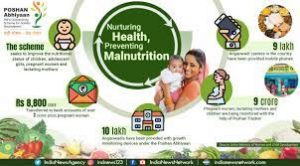
The Government has informed the Lok Sabha that State Governments and Union Territories have utilised only 56% of the total funds released under the Poshan Abhiyan or Nutrition Mission in the past three years.
- Out of a total amount of ₹5,312 crore disbursed by the Centre between financial years 2019 to 2021, a sum of ₹2,985 crore was utilised.
- The number of “severe acute malnourished” children in the country has become less than 15 lakh.
About Poshan Abhiyaan:
- The programme seeks to improve nutritional outcomes for children, pregnant women and lactating mothers.
- Launched in 2018 with specific targets to be achieved by 2022.
- It aims to reduce:
- Stunting and wasting by 2% a year (total 6% until 2022) among children.
- Anaemia by 3% a year (total 9%) among children, adolescent girls and pregnant women and lactating mothers.
- The target of the mission is to bring down stunting among children in the age group 0-6 years from 38.4% to 25% by 2022.
- More than a third of the children under five face stunting and wasting and 40% aged between one and four are anaemic. Over 50% of pregnant and other women were found to be anaemic, said the National Family Health Survey 4 released in 2016.
POSHAN 2.0:
- It is an umbrella scheme covering the Integrated Child Development Services (ICDS) (Anganwadi Services, Poshan Abhiyan, Scheme For Adolescent Girls, National Creche Scheme).
- It was announced in Union Budget 2021-22 by merging supplementary nutrition programmes and the POSHAN Abhiyaan.
- It was launched to strengthen nutritional content, delivery, outreach and outcome, with renewed focus on developing practices that nurture health, wellness and immunity to disease and malnutrition in the country.




